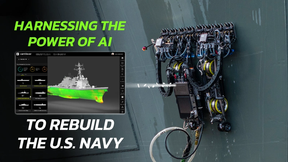Heightened Environmental Pressures, Rising Freight Rates Buoy Ship Repair Industry Announces New Contracts
All of the fundamental reasons why the ship repair industry should be experiencing fairly better times are now in place. Pressure on the shipowners' standards by classification societies and other legislative organizations have precipitated an increase in the number of repair contracts available throughout this year, and the increase in freight rates across the board also forecasts an increase in contract value as the year progresses.
Currently, the main market battle in the ship repair industry seems to be between the Singapore area, where there are five large shipyards, and the Middle East, where there are two. Despite recent inroads into its more traditional markets by Middle Eastern yards, the Singapore area remains a world leader in the ship repair and conversion industries. However, the level of activity between the two areas is becoming fiercely competitive. Figures released by the Association of Singapore Marine Industries (ASMI) showed that a total of 71 VLCCs were drydocked in the Singapore area during 1994. As compared with the Arabian Gulf yards, for the same period, Dubai Drydocks repaired 15 ULCCs and 37 VLCCs, and Bahrain's ASRY reported three ULCCs and 10 VLCCs. This equals a total of 65 large tankers repaired in the Arabian Gulf. One of the main methods by which the Singaporean government is assisting the yards is by increasing the ratio between Singaporean and foreign workers in the various shipyards from the past ratio of one Singaporean to two foreign workers to a ratio of 1:3. Expectedly, this move will allow the yards to maintain low prices and carry out expansion plans. Jurong Shipyard Ltd. (JSL) has already made moves to increase its labor force by announcing that it is building necessary housing for foreign workers.
This likely increase in worker levels is complemented by an expansion of facilities; and most Singapore yards have been involved in expansion projects, committing some $394 million in new docks, additional berths, equipment and machinery. The two largest expansion programs currently underway within the Singapore repair industry are: a 400,000-dwt capacity graving dock being built at the existing Tanjon Kling shipyard of JSL, the scheduled operational date being 1996; and the construction of a graving dock, capable of handling vessels up to 350,000 dwt at Keppel's Tuas facility. This new facility, which will complement two existing large docks at Tuas, will eventually replace Keppel's City yard, which is due for redevelopment. Apart from general repair work, Singapore has been at the forefront of the conversion industry for the past number of years, especially Keppel, Sembawang and JSL. These have recently been joined by Pan United, one of the most successful exponents of the conversion industry in the smaller end of the ship market, and Singapore Technologies.
The largest conversion contracts include the 137,684-dwt former NIS-registered conventional tanker Ellida, which arrived in Keppel during May this year for a nine-month conversion contract to change her application from a conventional crude carrier to t h a t of a Floating Production & Storage Offshore terminal (FPSO) for use by Shell in the Mauri Field off the coast of New Zealand. Keppel also recently completed work on a similar project involving the 149,494-dwt Cossack Pioneer, formerly the Chevron London, for Woodside Petroleum's operations in the Cossack Field off the Australian coast. JSL also recently made inroads into this market with a $20 million contract converting the 134,000-dwt tanker Mega Eagle into a FPSO, the first such conversion contract won by JSL from this specialized offshore market.
Meanwhile, Sembawang has been involved in both the FPSO and other offshore-related conversion work over recent years, the latest being the 127,435-dwt Panamanian bulk carrier Solitaire conversion, reportedly the largest such contract awarded to the ship repair industry on a worldwide basis. The project is currently underway in Sembawang, with the ship due for delivery as a specialized pipelayer to Allseas Engineering BV, Delft, during the latter part 1995.
As is the case with the Singapore area, the two large yards in the Middle East are also looking to a healthy future, and therefore are both in the expansion mode. Earlier this year, Bahrainbased Arab Shipbuilding & Repair Yard (ASRY) unveiled an ambitious $87 million expansion plan. The expansion program is aimed at increasing the present activities of the yard and maximizing profits, with financing likely to be provided via a mixture of bank loans and company resources.
The ASRY project includes dredging a channel and building a new quay, and construction is expected to begin next year. This new basin will be constructed in three phases, the first to involve a new 1,312-ft. (400-m) quayside space, with phases two and three involving 2,296.5-ft. (700-m) and 3,281-ft. (1,000-m) extensions to this berthage. This will allow for a greater amount of alongside work to be carried out, with the yard also beginning to look at the conversion market as well as general repairs. The yard already owns one of the industry's largest facilities, with a 1,230-ft. x 246-ft. (375-m x 75-m) graving dock for vessels up to 500,000 dwt and two floating docks, 826.7 ft. x 147.6 ft. (252 m x 45 m) and 774.7 ft x 134.5 ft. (227 m x 41 m), with lifting capacities of33,000 tons and 30,000 tons, respectively. There are plans for a second graving dock at a cost of $120 million, assuming favorable financial resources and market conditions. The yard reported that the number of ships repaired in the first five months of this year rose 16 percent on comparable 1994 figures to total 55. Operating income was also up with a 13 percent increase to $28 million. Meanwhile, Dubai Drydocks, with three graving docks capable of handling large tankers, leads the Middle East in this trade. During the latter part of last year Dubai Drydocks inaugurated its new 40,000-dwt capacity floating dock, which allowed the yard to enter the smaller market available in the Arabian Gulf. Apart from Singapore and the Middle East, others throughout the world have been involved in expansion programs, namely: Hong Kong United's (HUD) new floating dock, now fully operational, which was built in Singapore by Far East Levingston, part of the Keppel Group; the panamax capacity floating dock — which was purchased by Bergen's Mjellam & Karlsen (M&K), Norway, during 1994 — docked its firstvesselin June 1995. Two former naval yards in the U.S., located in Philadelphia and Charleston, are c u r r e n t l y being put under the privatization hammer, with the intention of attracting European bidders with desire to branch into the U.S. commercial repair (or even newbuilding) market.
This is all in addition to various new yards becoming operational and old yards re-opening over the past two years. These include: Thailand's Unithai, which is now virtually fully operational; Keppel's re-opening of Subic Bay Shipyard in the Philippines, and Cairncross Dockyard in Australia; Greece's Neorion Shipyard re-opening, A&P Appledore's lease of the former Neptune yard, which was once part of Swan Hunter; Wear Dockyard Group's takeover of the lease on the Hebburn Dry Dock, also once part of Swan Hunter; Coastline Industries' purchase of the three former Cammell Laird drydocks in Birkenhead; the Antwerp Shiprepairers re-opening; a management buyout at Cantieri Mediterraneo, Naples; new operators for the drydocks at Genoa; Vancouver Shipyard's return to operation of the large dock at Victoria, British Columbia; and Hong Kong's Yiu Lian Dockyard transfer of one of its floating docks to its new shipyard at Shekau, part of mainland China. The Mediterranean area is also one of re-organization. Portugal is about to lose its largest repair yard, Lisnave's Lisbon shipyard, with repair activities to be centralized at the company's Mitrena yard in Setubal. The future for some of the Spanish yards may lie down the path of privatization, although the problems faced by both Greece and Italy over privatization problems have been many, and therefore may not be a good solution for the Spanish industry. One of the main problems faced by both northern and southern Europe is the emergence of former naval yards in eastern Europe, both in the Baltic and Balkan states, onto the commercial market. This particularly applies to steelworking yards, where prices are below those of other European nations. Within northern Europe, the ferry refit market is about to become one of the most lucrative. The recent Estonia disaster in the Baltic Sea, the worst in European ferry and maritime operation, has again highlighted the problems of RoRo passenger/car ferries.
The main design fault of such ships is very clear. Designed like a large box, the main car deck, if penetrated by seawater, will swiftly fill up and cause the ship first to roll over, and then, inevitably, to sink. This disaster prompted the various authoritative organizations to rethink safety requirements onboard such ships and it will be to the repair industry that the ferry owners will t u rn to implement such design changes.





